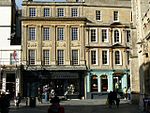The Corridor, Bath
Buildings and structures in Bath, SomersetCommercial buildings completed in 1825Grade II listed buildings in Bath, SomersetShopping arcades in EnglandShopping centres in Bath and North East Somerset ... and 1 more
Shopping malls established in 1825

The Corridor is one of the world's earliest retail arcades, designed by architect Henry Goodridge and built in 1825, in Bath, Somerset, England. The fashion for arranging shops in arcades arose in Paris in the late 18th Century. The Corridor followed the trend set by London's Burlington Arcade. The Grade II listed arcade has a glass roof. The High Street end has a Doric colonnade. Each end has marble columns.A musicians gallery, with a wrought iron balustrade and gilt lions heads and garlands, is in the centre of the arcade.Number 7 was the photographic studio of William Friese-Greene.
Excerpt from the Wikipedia article The Corridor, Bath (License: CC BY-SA 3.0, Authors, Images).The Corridor, Bath
The Corridor, Bath Kingsmead
Geographical coordinates (GPS) Address Nearby Places Show on map
Geographical coordinates (GPS)
| Latitude | Longitude |
|---|---|
| N 51.382222222222 ° | E -2.3591666666667 ° |
Address
The Corridor
The Corridor
BA1 5AH Bath, Kingsmead
England, United Kingdom
Open on Google Maps











